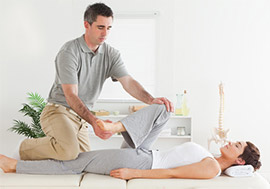Patient Education
Reducing Joint Pain and Restoring Mobility
Reducing Joint Pain and Restoring Mobility
If you suffer from joint pain that is restricting your range of motion and interfering with your daily activities, there is help available. Physiotherapy can help to reduce your joint pain and improve your mobility by incorporating a variety of techniques into a treatment program, including manual therapy, stretching and strengthening exercises.
Human movement is dependent on the range of motion of the joints of the body. Range of motion can be limited by either the joints themselves or by the muscles, nerves and connective tissue that surround the joints. There are a variety of conditions that can lead to you feeling stiff and restricted, including muscular tightness, osteoarthritis, or even nerve entrapment. Reduced range of motion impairs the ability of the body to function properly, which can result in joint pain and an inability to do the things you want or need to do in your day.
Physiotherapy aims to reduce joint pain by restoring joint motion and improving muscle function. After a thorough assessment, your physiotherapist will determine what is causing your joint stiffness and discomfort and will develop a program to help you regain and maintain as much of your available joint range as possible. Treatments with physiotherapy may include:
- Manual therapy – joint mobilization may be used to relieve joint restriction, and soft tissue mobilization may be used to relieve muscle tension
- Stretching – a treatment program may include a combination of different stretching exercises, including:
- Active stretches: patients move their limbs without assistance
- Active-assistive stretches: the therapist assists the patient in moving their limbs because there is too much discomfort or the muscles are too weak
- Passive stretches: the therapist moves the limb for the patient
- Strengthening – initially, when a muscle is very weak, gravity provides adequate resistance. Once the muscles are stronger, strength can be gained with progressive resistive exercises by adding manual or mechanical resistance, in the form of springs or weights.
- Nerve Gliding -- nerves run like strings from the spinal cord out to your limbs. They pass through and around organs, muscles, joints and connective tissue. Sometimes the nerve can become stuck or compressed where it passes through these structures creating a feeling of stretch, burn, or pain. This is called nerve entrapment. Nerves don’t like to be stretched aggressively so gentle nerve gliding techniques guided by your physiotherapist can start to address any nerve-related loss in range of motion.
If you suffer from osteoarthritis your physiotherapist may make additional recommendations to help reduce your joint pain and improve joint mobility.
These therapies may include: tai chi, aerobic exercise, and/or hydrotherapy.
- Tai chi – a Chinese martial art that is often used to reduce stress and tension while moving the body through functional range of motion. Participants are encouraged to achieve complete relaxation. The movements utilized in Tai chi are soft, slow and flowing.
- Aerobic exercise – activities such as cycling and walking are often encouraged to help reduce joint pain and improve functioning by maintaining muscle conditioning, good blood flow, and optimizing joint lubrication.
- Hydrotherapy – involves using water (at any temperature) for the purpose of healing, an example being aquatic therapy where exercises are carried out in a heated pool. Water often allows you greater access to range of motion due to the weight-reduced environment and hydrostatic pressure.
If joint pain and reduced range of motion are preventing you from feeling supple and staying active, you could benefit greatly from physiotherapy. Undergoing a comprehensive evaluation by a physiotherapist at Skill Builders is one of the best ways to gain an understanding of how you can enhance your physical state. Our physiotherapists will sort out what your barriers to motion are, and will create a program that is specific to your needs to help to reduce joint pain and restore optimal mobility.
References
- Page P. Current concepts in muscle stretching for exercise and rehabilitation.. International Journal of Sports Physical Therapy. 2012;7(1):109. Available at: http://www.ncbi.nlm.nih.gov/pmc/articles/PMC3273886/. Accessed September 18, 2016.
- Bhatia D, Bejarano T, Novo M. Current interventions in the management of knee osteoarthritis. Journal of Pharmacy and Bioallied Sciences. 2013;5(1):30. doi:10.4103/0975-7406.106561.
- Physical Therapy (PT). Merck Manuals Professional Edition. 2016. Available at: http://www.merckmanuals.com/professional/special-subjects/rehabilitation/physical-therapy-pt. Accessed September 18, 2016.
- Nonarthritic Hip Joint Pain: Nonarthritic Hip Joint Pain: Journal of Orthopaedic & Sports Physical Therapy: Vol 44, No 6. Journal of Orthopaedic & Sports Physical Therapy. 2016. Available at: http://www.jospt.org/doi/full/10.2519/jospt.2014.0302. Accessed September 18, 2016.
